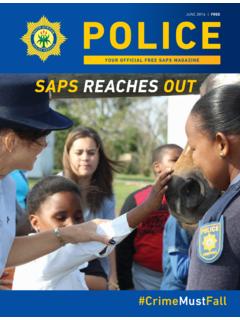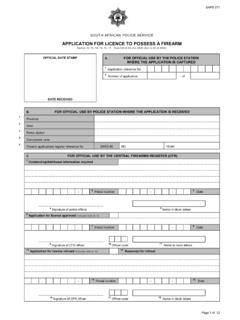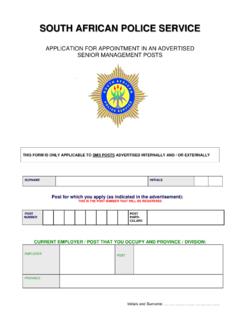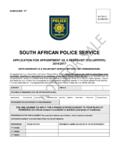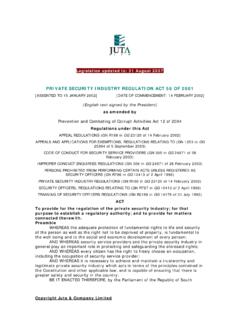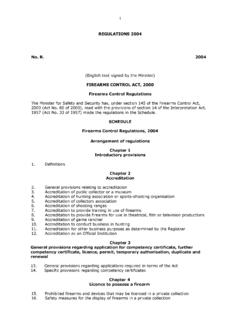Transcription of Victim Empowerment Service in the South African Police …
1 AVictim Empowerment Service in the South AfricanPolice ServiceBCompiled by: Division: Visible Policing, Component Crime Prevention,Section Gender based Violence and Victim Empowerment Division Detective Service , Component Family Violence, Child Protection and Sexual Offences Investigation (FCS)Design & Layout: SAPS Coporate CommunicationMarketing & Public Relations1 Index1. Introduction2. What is a Victim -friendly Service ?3. Framework for services to victims4. Rights of victims of crime5. services Police officials provide to victims of crime6. Police official s first contact with the victim7. Interview and obtaining the Victim s statement 8. Registering the case docket9. The role of the investigating officer10. The role of the commander/supervisors11. Referral to Victim support services12. The procedure to follow when referring a Victim of a crime to a professional Service provider13. The functioning of Victim -friendly rooms (VFRs) at Police stations14.
2 The different Victim support Service centres available in the community123 Victim Empowerment Service in the South African Police Service1. IntroductionThe South African Police Service is the initial point of entry to the criminal justice system in the majority of cases, and is therefore responsible for ensuring that the victims of crime, especially sexual offences and other serious and violent crimes, are provided with a Victim -friendly What is a Victim -friendly Service ?It is a Service where the dignity and rights of victims are protected, and the Victim is empowered and not subjected to secondary victimization by the inefficiency of the members of the criminal justice system. The four basic elements of Victim Empowerment are - emotional support practical support providing information referral to professional support services 3. Framework for services to victimsThe following serves are a framework for services to victims : Service Charter for victims of Crime in South Africa4 Minimum Standards for services to victims of crime Legislation SAPS instructions, for example: National Instruction 2/2012 Victim Empowerment National Instruction 7/1999 - Domestic Violence National Instruction 3/2008 - Sexual Offences National Instruction 2/2010 - Children in Conflict with the Law National Instruction 3/2010 - The Care and Protection of Children in terms of the Children s Act Standing Operating Procedures for the reporting of FCS-related Crimes (FCS = Family Violence, Child Protection and Sexual Offences Unit)4.
3 Rights of victims of crime victims have the following rights: The right to be treated with fairness, and with respect for dignity and privacy The right to offer information The right to receive information The right to protection5 The right to assistance The right to compensation The right to restitution5. services Police officials provide to victims of crimePolice officials must comply with the different instructions, for example the SAPS National Instructions. All victims must be treated with fairness, respect and courtesy, in private, without discrimination, regardless of circumstances, population group, gender, age, disability, sexual orientation and appearance. 6. Police officials first contact with the victimThe first contact of the Police official refers to, for example - a telephone call from the reporter ( Victim , witness, concerned person, etc) the Victim visiting the CSC a call-out to the crime scene where the Victim first Police official who comes into contact with the Victim , must provide the following services /support to the Victim : When receiving details of a complaint, the Police official must react Introduce yourself to the Victim .
4 Determine and ensure the safety of the Victim . Arrange for medical assistance, if necessary. Ensure that all possible evidence is preserved and collected from the medical practitioners/hospital/clinic. Interview the Victim in a language that he/she understands. If the member cannot speak the language, he/she must arrange for another member who is able to converse in the same language, or arrange an interpreter. If the Victim requests that he/she is interviewed by a Police official of the same gender, all possible attempts must be made to adhere to the request. Inform the Victim that he/she may have a person present for support during the different processes, for example the interview, statement taking, medical examination. Inform the Victim of the different/applicable processes that will follow (statement taking, registering of case docket , medical examination, investigation). Notify the relevant detective performing standby duties of the case as soon as possible.
5 Ensure that the detective attends to the case as soon as Interview and obtaining the Victim s statementThe Police official must attend to the following when interviewing and obtaining the statement of a Victim :78 Take a statement in a professional and sensitive manner, with respect for the Victim s right to privacy and complete all the necessary forms to register the crime. Interview and statement of adult victims (18 years and older) If possible, the Police official must be able to speak and understand the language used by the Victim The exact words of the Victim must be contained in the statement If the Victim is too traumatised to provide detailed information - obtain a brief, preliminary statement or obtain a statement from the person accompanying the Victim obtain an in-depth statement later when the Victim is able to do so (see paragraph 18 of NI 3/2008) Should the Victim wish to provide a detailed statement immediately, obtain the detailed statement Inform the Victim of the different processes that will follow.
6 Interview and statement of a child Victim (under the age of 18 years) For the correct format of a child s statement, see Annexure F of NI 3/2008 Guidelines relating to the taking of a statement of a child Victim A Police official who has been trained to interview and to 9obtain a statement from the child, must deal with the child Victim . The Police official must be able to speak and understand the language used by the child Victim . The use of a translator must be the last resort. The exact words of the child must be contained in the statement. If the child Victim is too traumatised to provide detailed information - obtain a brief, preliminary statement or obtain a statement from the person accompanying the Victim obtain an in-depth statement later when the Victim is able to do so (see paragraph 18 of NI 3/2008) If the child is too young or not able to verbalise the details of the incident(s), a forensic social worker must give assistance with conducting a forensic assessment.
7 A child s statement must be obtained in the presence of the parent/guardian, unless - it is not in the best interest of the child the parent/guardian is the alleged offender the child requests to be interviewed without the parent/guardian being present. Content of the Victim s statement10 Record the Victim s exact words in the statement. Afford him/her the opportunity to read his/her statement and make any changes to it. If the Victim is unable to read it, read the statement to him/her. The statement of the complainant should contain the following (should it not be included in the original statement, obtain an additional statement): Elements of the crime Detailed description of what had happened before, during and after the commission of the crime(s) (actions of Victim and offender) Detailed description of injuries sustained ( Victim ) and caused (offender) during the incident(s) Detailed description of threats and/or objects used (for example condoms, ropes, firearms) Detailed description of any items removed from the crime scene and ability to identify items, if applicable Detailed description of the surroundings where the incident(s) took place Details of the alleged offender, if known Full names, aliases, addresses, contact details Relationship between Victim and offender (stranger, family member, spouse, partner, friend, etc) Physical description of the suspect (population 11group, gender, age, physical appearance, deformities, tattoos, etc)
8 If unknown Physical description of the suspect (population group, gender, age, physical appearance, deformities, tattoos, etc) Personal characteristics (defective speech, language use, and modus operandi) Indication whether he/she will be able to identify the suspect(s) and/or compile a facial identikit Details of the person to whom she/he reported the details of the incident(s) the first time (first report witness) Indication of possible witness(es), their actions/involvement and their details (name, surname, alias, contact details)8. Registering the case docket Register the case docket immediately/as soon as possible as the CAS reference number will be required for the follow-up processes, medical examination, circulation of the details of stolen property, requesting the services of the investigating experts/aids (photographer, fingerprint experts, dogs, etc). Inform the Victim of the different investigation processes Provide the Victim with the details of the Police station and CAS reference number.
9 12139. The role of the investigating officerThe investigating officer must - conclude the full investigation of a case as soon as possible explain Police investigation procedures that involve the Victim provide your contact details to the Victim , should he/she have any enquiries with regard to the case consider the safety of victims and other witnesses a priority during the investigation. If possible, mechanisms should be adopted to prevent the offender from identifying witnesses (use one-way mirror facilities) keep the Victim informed of progress made with the investigation (medical examinations, identification parades, identification and arrest of the alleged suspect), court procedures (decision of the prosecutor to prosecute/not prosecute, first appearance of the accused, bail hearing, bail conditions, trial dates, postponements, date required to testify, pre-trial meeting with the prosecutor, outcome of the trial), and the date and place when seized property may be collected Prepare the Victim for the court process Inform the Victim that the accused will have access to the docket .
10 If the Victim has any specific reason for not wanting the accused to have this information, submit the request to the prosecutor to withhold the name and address of the Victim Inform the Victim of available support/counselling services14 Inform the prosecutor if there is reason to believe that a Victim or other witness may be subjected to further threats, violence or harassment, as this will be a consideration in the bail hearing. Advise the Victim on steps to be taken if the suspect/accused threatens or interferes with him/her. Inform the Victim of the witness protection programme, and if necessary, accommodate the Victim Do not make the names and addresses of victims known to the media and this information should not be read aloud in open courts. Details which would identify them, should be withheld if possible ensure that all property held for evidentiary purposes are returned as soon as possible, if the Victim may possess it legally inform the next of kin personally of the death of a Victim and provide the necessary assistance during the identification procedures.
